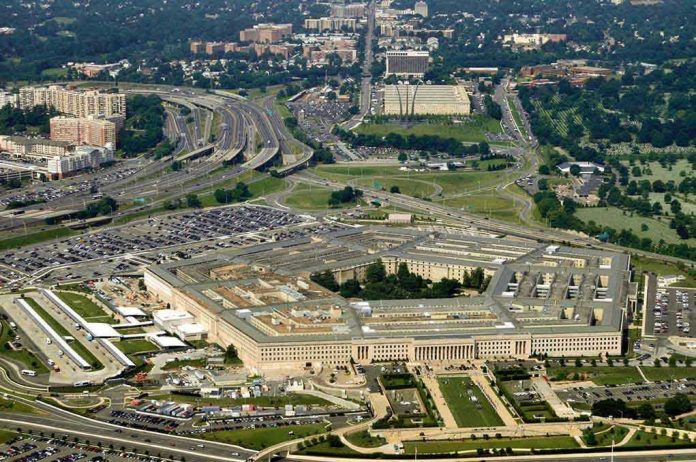
America’s next military conflict may be revealed not through secret briefings, but by the pixelated evidence in commercial satellite photos—where expansion, abandonment, and new construction quietly redraw the map of U.S. power in real time.
Story Snapshot
- Satellite imagery is exposing the secret expansion and contraction of U.S. military bases worldwide.
- Defense priorities are shifting from Europe and the Middle East to the Indo-Pacific and Indian Ocean.
- Recent satellite-confirmed deployments and withdrawals signal new flashpoints and vulnerabilities.
- These changes reflect evolving threats, fiscal pressures, and rising host nation resistance.
Satellites Unmask the Pentagon’s Global Chessboard
Military secrecy isn’t what it used to be. Once, the location and size of American bases were privileged knowledge—today, satellites orbit above, capturing every runway extension and fence line. Recent imagery reveals bold new construction on Tinian, a remote Pacific island, where the U.S. is laying down an 8,600-foot runway and massive fuel storage. This $800 million investment marks a decisive pivot toward countering China, echoing the long arc of U.S. strategy since World War II and the Cold War’s sprawling network of overseas outposts.
Far from being simply defensive, these projects foreshadow new offensive capabilities and rapid force projection. The Mariana Islands, once a strategic backwater, now loom large in the calculus of Indo-Pacific deterrence. Meanwhile, satellites confirm that Diego Garcia—long shrouded in secrecy—is bristling with newly arrived stealth bombers, dispatched as a visible warning ahead of nuclear talks with Iran. Each pixel tells a story of American resolve, but also of anxious adaptation.
Strategic Expansion and Shrinking Footprints
The U.S. military’s footprint is both stretching and shrinking. Modern priorities have rendered some legacy bases obsolete: Afghanistan’s sprawling installations, once critical to the War on Terror, now stand abandoned after the 2021 withdrawal. In Qatar, recent satellite data captured the hurried evacuation of aircraft just before Iranian missile strikes left visible damage to communications systems—contradicting official claims of interception success.
In Europe, Cold War-era bases are downsizing, some mothballed as fiscal constraints and shifting alliances take hold. Defense contractors, always adaptable, follow the funding, pivoting toward construction and support contracts in the Indo-Pacific. Host nations, from Germany to Japan, weigh the benefits of American presence against rising domestic opposition and environmental concerns—satellite images are now as useful to activists as to generals.
Who Benefits, Who Pushes Back
Power dynamics in military basing have grown more complex. The U.S. Department of Defense holds sway over host nations by offering security guarantees and economic incentives, but that leverage is eroding. As base expansion brings jobs and infrastructure, it also triggers sovereignty disputes and environmental backlash. Governments in the UK and Japan negotiate the fine line between cooperation and autonomy, mindful of local protests and global adversaries.
Adversary states—China, Russia, Iran—scrutinize American moves with their own satellites. Each expansion is met with new anti-access strategies, missile deployments, and cyber threats. The race for “agile basing” and “distributed lethality” drives the U.S. to smaller, more secretive “lily pad” sites, keeping American forces mobile and harder to target. Congressional committees, Pentagon officials, and host nation leaders all influence these decisions, but the final arbiter may be the unblinking eye in the sky.
Flashpoints, Vulnerabilities, and the Next Frontier
In the short term, expanded bases like Tinian and Diego Garcia enhance deterrence and rapid response capability. Yet they also heighten tensions, especially as adversaries adapt with longer-range missiles and more sophisticated surveillance. Long-term, the trend is toward flexibility: fewer large “Little Americas,” more nimble outposts designed to survive attack and project force across vast distances.
Satellites reveal America's secret, shrinking, and expanding military bases https://t.co/fsWEaqMj1k
— Business Insider (@BusinessInsider) October 17, 2025
Local communities face the dual impact of economic gains and environmental risks. For U.S. personnel, the constant churn means uncertainty—and for host governments, the struggle to balance strategic interests with political realities. Environmental experts warn of the ecological damage wrought by new construction, especially on fragile island ecosystems. Meanwhile, the satellite intelligence industry surges, its data informing journalists, watchdogs, and adversaries alike.
Expert Insight: Security or Provocation?
David Vine, a leading authority on overseas bases, questions whether this vast network actually secures American interests or instead provokes adversaries and strains alliances. Military analysts insist agile basing is essential in an era of anti-access/area denial threats, citing the need for rapid force projection and survivability. Scholars trace the historical pattern: expansion and contraction, always in response to new threats and technological advances.
Business Insider’s “View From Above” series and corroborating reports from the Associated Press provide independently verified evidence of base construction, deployments, and damage. Where official statements downplay vulnerability, satellite images offer objective proof—especially after the Iranian strike on Qatar. This transparency is reshaping public debate, challenging American policymakers to justify every fence line and runway extension.
Sources:
Satellite images show American military bases expanding, shrinking
Satellites reveal America’s secret, shrinking, and expanding military bases (Business Insider)



